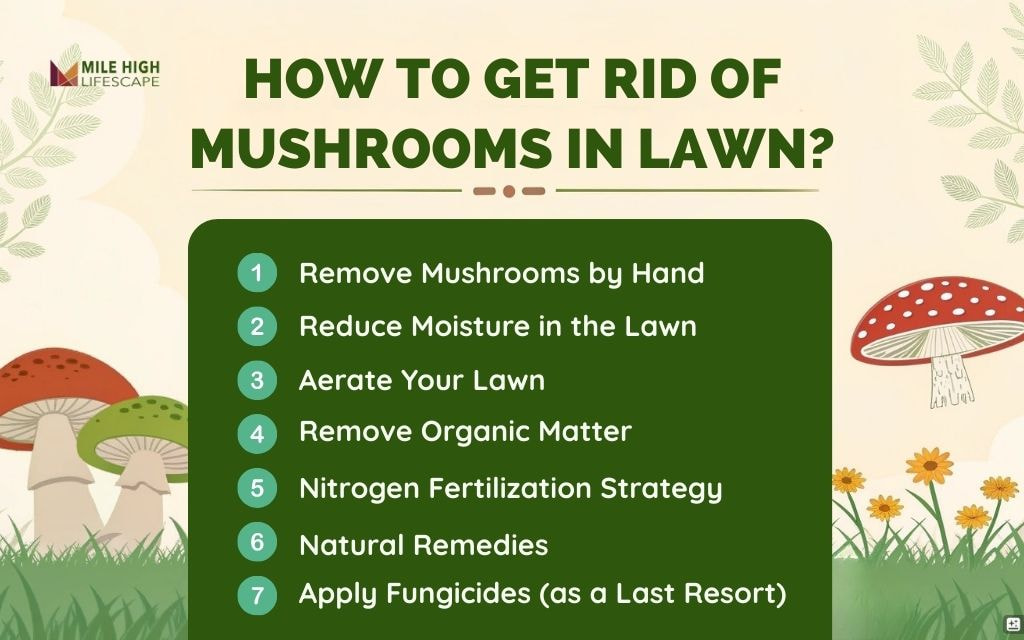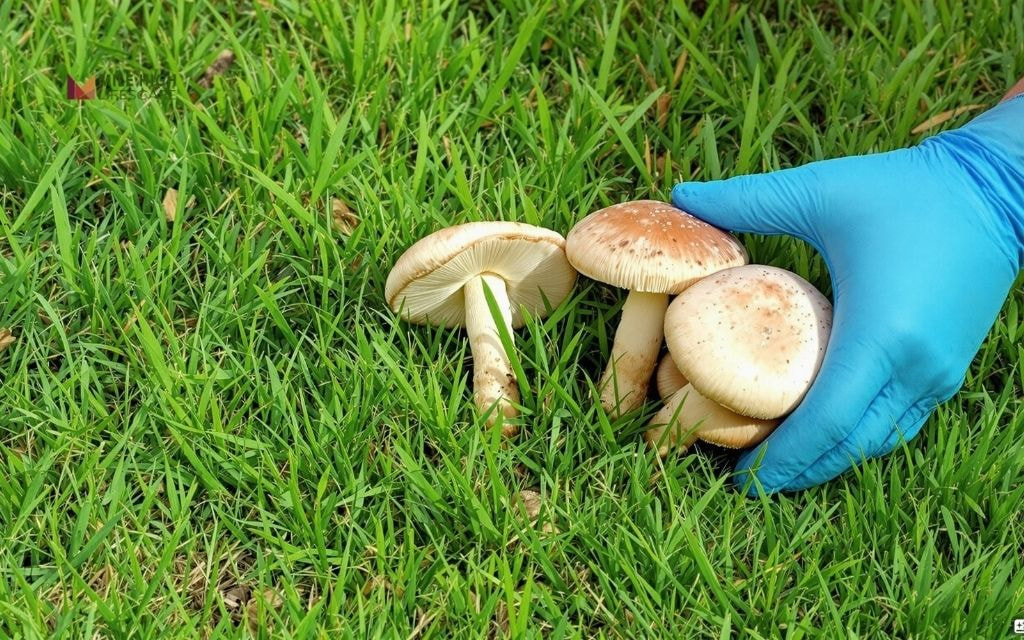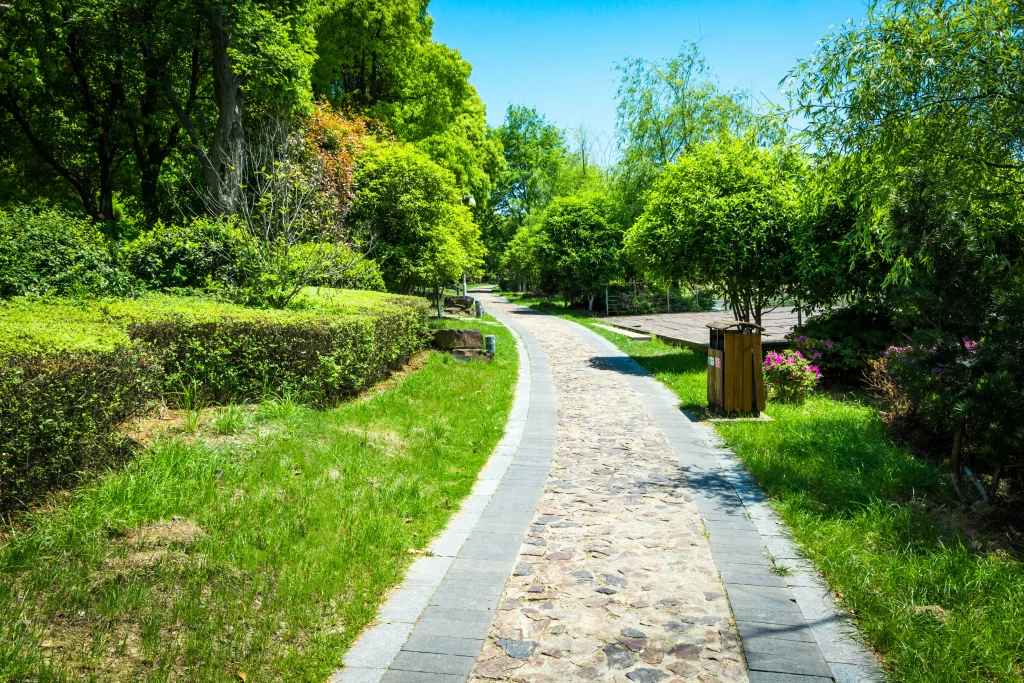Denver homeowners often discover unwelcome visitors on their lawns after rainfall – mushrooms. These fungi thrive in our region’s unique climate where summer thunderstorms combine with cool evenings to create perfect growing conditions.
Mushrooms typically appear as white, brown, or tan caps sprouting from your lawn, sometimes in clusters or rings. Some examples are white button mushrooms, fairy ring fungi, and inky cap mushrooms.
While mushrooms themselves don’t harm your grass directly, their presence signals underlying issues with moisture, decaying organic matter in the lawn, or soil compaction.
This guide breaks down everything Denver residents need to know about how to get rid of mushrooms in lawn – from identification and removal to year-round prevention – using methods that are effective, safe, and friendly to the unique conditions of Colorado soils and climate.
Why Mushrooms Appear in Lawns
Mushrooms don’t just appear on a whim; they’re the result of specific environmental factors – many common to Denver’s climate. Understanding these triggers is the first step toward lasting solutions and healthy lawn maintenance.
- Moisture Levels: After Denver’s famous summer rains, followed by cool evenings, excess moisture lingers, creating ideal mushroom habitats.
- Organic Matter: Decaying tree roots, thatch, leaves, and stumps in the soil provide mushrooms with a food source for decomposition and growth.
- Soil Compaction: Colorado soils, especially clay-heavy ones, can quickly compact, restricting drainage and leading to fungal outbreaks.
- Shade: Mushrooms favor dark, damp areas – so lawns shaded by trees, fences, or buildings are at higher risk for recurring issues.
Knowing the cause makes it easier to pick the most effective solution for natural mushroom control lawn.

How To Get Rid Of Mushrooms In Lawn?
Ready to remove mushrooms from lawn permanently? Denver’s climate demands specific, science-backed methods. Here’s a step-by-step, actionable guide:
#1: Remove Mushrooms by Hand
For small mushroom patches, manual removal provides immediate results. Wear gloves and remove the entire mushroom including the cap to prevent spore spread.
The key is grabbing the mushroom at its base and pulling with a gentle twisting motion to remove as much of the underground portion as possible.
Bag and dispose of mushrooms with household trash rather than composting them to prevent spreading spores to other areas of your yard.
For larger infestations, consider using a small garden trowel to dig slightly below the mushroom to ensure complete removal.
#2: Reduce Moisture in the Lawn
Adjust your watering schedule to eliminate excess moisture. Denver lawns typically need deep, infrequent watering rather than daily light sprinkling.
Water early morning (between 4-10 AM) to allow grass blades to dry completely during the day. This timing works particularly well in our low-humidity climate.
If you notice standing water in certain areas, consider regrading those sections or installing additional drainage to prevent water accumulation.
#3: Aerate Your Lawn
Break up compacted soil through core aeration, which removes small plugs of soil to improve drainage and reduce conditions that favor mushroom growth. Core aerators that remove actual soil plugs work far better than spike aerators that simply poke holes.
In Denver, perform this service in spring (April-May) or fall (September-October) when Kentucky bluegrass and fescue lawns actively grow.
For severe compaction, consider double-pass aeration where you make two perpendicular passes across the lawn.
Following aeration with a top dressing of compost (¼ inch layer) can further improve soil structure and drainage, creating conditions less favorable for mushroom development.
#4: Remove Organic Matter
Regularly clear your lawn of decaying material that feeds fungal networks. Remove fallen leaves promptly, especially from maple and ash trees common in Denver neighborhoods.
Check for buried wood, old tree stumps, or construction debris that might lie beneath the surface of newer developments.
Consider using a soil probe to check for buried debris in areas with persistent mushroom problems.
#5: Nitrogen Fertilization Strategy
Apply a nitrogen-rich fertilizer to speed up the decomposition process of organic matter. Use 0.5 to 1 pound of nitrogen per 1,000 square feet of lawn area.
In Denver’s alkaline soils, look for fertilizers containing sulfur or iron to help lower the pH slightly, creating less favorable conditions for mushroom growth.
This approach works particularly well in early summer (June) when soil temperatures have warmed but before the intense heat of July and August. The additional nitrogen not only discourages mushrooms but also promotes vigorous grass growth that can outcompete fungal development.
#6: Natural Remedies
For environmentally-conscious homeowners, several natural approaches can help manage mushroom growth. Create a solution of 2-3 tablespoons of baking soda in a gallon of water and spray directly on mushrooms and affected areas. The alkaline nature of this solution disrupts fungal growth.
Alternatively, mix 1 part vinegar with 4 parts water for a more acidic approach that can kill mushrooms on contact without significantly harming your grass.
For spot treatment of individual mushrooms, digging them out and applying a small amount of dish soap diluted in water (1 teaspoon per gallon) to the hole can discourage regrowth while being relatively safe for surrounding turf.
#7: Apply Fungicides (as a Last Resort)
When persistent mushroom problems occur despite other measures, consider commercial fungicide products. Choose products containing chlorothalonil or azoxystrobin labeled specifically for lawn use.
Apply during dry periods for maximum effectiveness, and always follow application instructions precisely to protect yourself, pets, and local waterways.
For best results, apply fungicides when the soil temperature is between 60-80°F – typically late spring through early fall in Denver.

Preventing Mushrooms in Your Lawn
Prevention requires addressing the environmental factors that support mushroom growth before they appear. These strategies work particularly well for Denver’s climate and soil types.
- Improve Lawn Drainage: Mix in compost or fine sand to clay-heavy soils and low spots, boosting absorption and preventing puddles. French drains may be recommended for chronic wet areas.
- Mow Regularly: Trim your grass to a height of 2.5–3 inches. Taller grass shades soil, reducing sunlight for spores and limiting outbreaks.
- Adjust Watering Habits: Water deeply once or twice a week to encourage deep roots – shallow, frequent watering leads to excess surface moisture.
- Use Fungus-Resistant Grass Varieties: Opt for Kentucky bluegrass or fescue, which better tolerate Denver’s climate and resist fungal issues.
- Install Better Drainage: If your yard has chronic puddling, consider professional solutions like French drains or gravel trenches to eliminate excess moisture.
By focusing on prevention, you’ll make your lawn more resilient and achieve long-term, natural mushroom control lawn results.
Are Mushrooms Bad for Your Lawn?
Discovering mushrooms in your yard is not always a cause for alarm. In fact, most common Denver lawn mushrooms don’t harm turf directly.
Below, we highlight both the benefits and potential concerns so you can make an informed decision.
Why Are Mushrooms Not Always Bad?
Mushrooms are natural decomposers helping break down organic matter – like leaves, wood, and roots – recycling nutrients and promoting soil enrichment. They don’t typically consume grass roots or compete for nutrients.
When Mushrooms Can Be a Concern?
- Their presence usually signals excess moisture, poor drainage, or decaying matter in your lawn (think of them as nature’s “check engine” light).
- They can be unsightly, indicate possible lawn fungus issues, or hide toxins that challenge both pets and children’s safety.
- Persistent mushrooms might hint at more serious problems, like overlooked decaying wood or compacted soil in your yard.

When to Call a Professional for Mushroom Control
For most Denver homeowners, do-it-yourself mushroom control methods work well. However, you may need expert help from Mile High Lifescape if you notice any of the following:
- Extensive mushroom growth that reappears a few weeks after removal.
- Declining lawn health, yellowing patches, or visible signs of fungal disease.
- Recurring problems with soil compaction or areas that remain soggy for more than 24 hours.
- Need for specialized fungicide treatments to safely protect children, pets, and plants.
- Loss of curb appeal, or if mushrooms diminish your enjoyment of your outdoor space.
Mile High Lifescape Services include:
- Lawn Fungus Control: Customized, environmentally friendly treatments targeting mushrooms and other lawn fungi.
- Soil Aeration and Lawn Care: Aeration, fertilization, and topdressing to keep your lawn resilient against fungi.
- Complete Lawn Maintenance: Year-round maintenance packages tailored to Denver’s unique climate, ensuring your yard remains lush, green, and mushroom-free.
Conclusion
Mushrooms may be common in Denver lawns, but you don’t have to put up with them. By identifying the underlying causes, taking proactive steps for healthy lawn maintenance, and using natural or targeted removal methods, you can maintain a beautiful yard – one that’s safe for family and pets.
Don’t let lawn mushrooms take over. Make use of proper watering, regular aeration, organic matter removal, and, when necessary, tailored fungicide applications.
And if you need expert backup, Mile High Lifescape is here to help with lawn fungus control, aeration, and complete lawn care services for Denver’s unique soil and climate.
Contact Mile High Lifescape today at (303) 877-9091 for a free consultation or visit our website to learn how we can help you maintain a healthy, mushroom-free lawn year-round.
Frequently Asked Questions (FAQs)
What will kill mushrooms but not grass?
Several strategies can kill mushrooms without harming grass, including hand removal, improving drainage, reducing moisture, lawn aeration, and natural DIY solutions like sprinkling baking soda or using a light vinegar solution (vinegar solution for lawn mushroom control) applied directly to mushrooms. Always test on a small spot first and avoid over-application.
What is the best mushroom killer for your lawn?
The best mushroom killer for your lawn is a combination of prevention and targeted treatment. Start with hand-picking, aerating, and adjusting watering habits. For persistent infestations, use a fungicide labeled for lawns and safe for pets and children – follow the manufacturer’s instructions closely for safe and effective results.
How do I permanently get rid of mushrooms?
To remove mushrooms from lawn permanently, try these 5 strategies:
- Remove organic debris and dead wood from your lawn regularly.
- Improve drainage through aeration and soil amendment.
- Adjust watering to avoid excess surface moisture.
- Increase sunlight by trimming trees or shrubs to reduce shade.
- Use fungicides as a last step for persistent or large outbreaks.
Why are mushrooms growing in my lawn?
Mushrooms grow in my lawn because excess moisture, decaying organic matter (like roots, leaves, or stumps), poor drainage, and shaded areas create perfect conditions for fungal growth, especially after summer rains and in compacted or clay-heavy Denver soil.
Are yard mushrooms poisonous to dogs?
Yes, some yard mushrooms can be poisonous to dogs and other pets. Never allow pets to eat unidentified mushrooms in the yard, as varieties like stinkhorn mushrooms or certain puffballs can cause illness. If in doubt, remove mushrooms immediately and consult your veterinarian if ingestion occurs.
